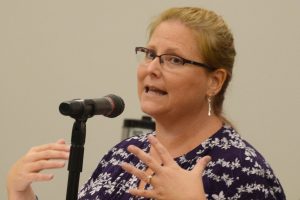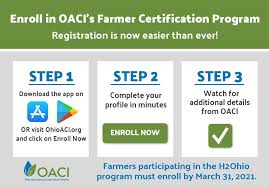Conservation, Homepage Slider, Water Quality
Ohio Agriculture Conservation Initiative Deadline Fast Approaching
By Dusty Sonnenberg, CCA, Ohio Field Leader: a project of the Ohio Soybean Council and soybean checkoff.
Acronyms and Initialisms are abundant in agriculture today. Almost every discussion at the USDA Farm Service Agency (FSA) office, or County Soil and Water Conservation District (SWCD) office involve them. Two of the latest initialisms that some producers may not be familiar with include: OACC and OACI. “The OACI is a product of the OACC,” said Kris Swartz, farmer from Wood County, Ohio, and Chairman of OACI. “The OACC is the Ohio Agricultural Conservation Council, which is a group of agricultural and environmental organizations, and educational entities that have the goal of improving water quality in Ohio.”
The Ohio Agriculture Conservation Initiative (OACI) is an innovative collaboration of agricultural, conservation, environmental and research communities. OACI was formed in early 2019 to strategically address Ohio’s water quality issues. “The main goal of OACI is to help in decision making on the farm.

We want to help farmers understand conservation practices, and think about which practices are really going to improve water quality,” said Nikki Hawk, OACI Project Leader with the Ohio Federation of Soil and Water Conservation Districts. An initial goal for OACI is to establish a baseline understanding of current conservation and nutrient management practices being implemented on Ohio farm fields.
Efforts to restore and protect Ohio’s water quality are an ongoing goal of 18 partners in OACI. Those 18 partners include: Ohio Soybean Council, Ohio Corn and Wheat Growers, Ohio Dairy Producers Association, Ohio Farm Bureau, Ohio Pork Council, Ohio Poultry Association, Ohio Cattlemen’s Association, Ohio Sheep Improvement Association, Ohio AgriBusiness Association, Environmental Defense Fund, Ohio Environmental Council, Ohio Federation of Soil and Water Conservation Districts, The Nature Conservancy, National Center for Water Quality Research/Heidelberg University, The Fertilizer Institute, Ohio Conservation Federation, American Farmland Trust, and The Ohio State University, College of Food, Agricultural and Environmental Sciences.
Farmers can sign-up for OACI quickly and easily. “A farmer can just download the OACI app on their smartphone or computer and fill out the basic profile information,” said Swartz. “I liken it to filling out the information card for a farm magazine. It is quick and easy, and that is all we are asking farmers to do in the first year.”
“Farmers that signed H2Ohio contracts also signed a commitment form to enroll in OACI,” said Hawk. “So far we have 90% of the farmers with the commitment form signed and are fast approaching 100%. Of that number, 30% have already gone online, and completed the OACI profile. The deadline to complete the OACI profile is March 31st.”
The OACI program is not strictly for farmers in Northwest Ohio that have H2Ohio contracts. “The OACI platform is open to farmers across the state to register and complete a profile,” said Swartz. “The OACI is kind of like an agricultural brag book about all the good things farmers are doing for the environment across the state. It is a tool we can use to collect data and show the general public and decision makers the things farmers are really doing on Ohio farms. Currently we do not have solid statistics on the actual number of conservation practices in use in the state. We see a lot of things derived from modeling, but this data can help to ground proof those models.”
In future years the goal is to expand the data collected. “The first year we just want farmers to complete the profile,” said Swartz. “The second year, we want to expand the data we collect to include conservation practices being used on their farms. This information will not be identifiable for individual farms, but will be aggregated at a watershed level. All the organizations that are a part of OACI agreed to that from the start.”
“Data security is definitely critically important in this process,” said Hawk. “That was also made very clear by every partner that is involved in this project.”
The data that will be collected is not anything that would be considered highly sensitive. “Most of the questions that will be asked in the future are things that would be observable from the road,” said Swartz. “They will not ask for soil tests or yields.”
To hear first hand from Kris Swartz and Nikki Hawk, listen to the Ohio Field Leader Podcast.
The deadline to complete the OACI profile is March 31st. To get more information about OACI, or to register, visit: https://ohioaci.org